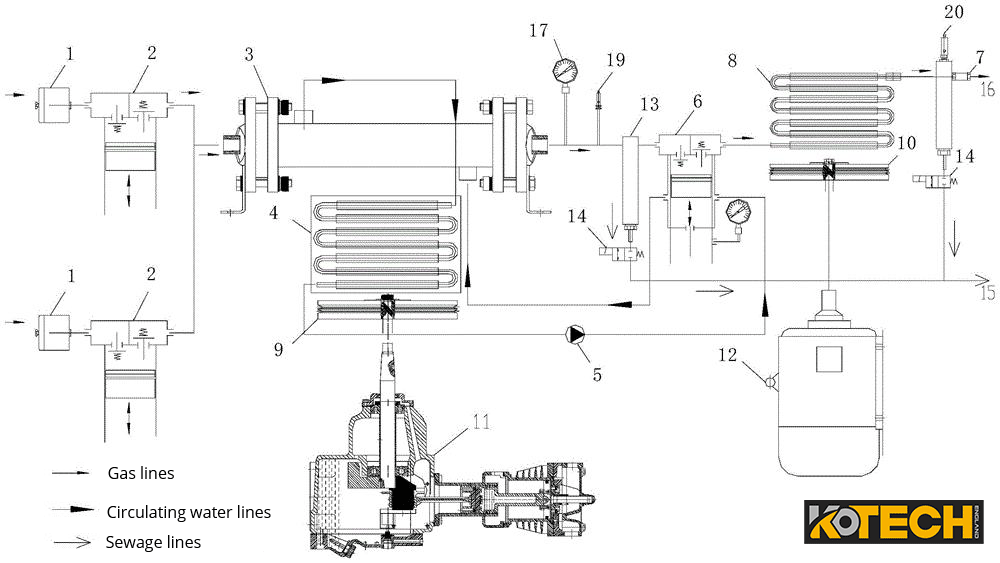How Does a Slide Valve Work on a Screw Compressor?
Slide Valve Screw Compressor Product Introduction:
Screw-type air compressors have become the new mainstream in the development of air compressors today. Compared to piston compressors with equivalent power, they have unparalleled advantages, offering superior and reliable performance. The small vibration, low noise, high efficiency, and lack of easily worn parts contribute to their excellence.
The precise coordination between the main and auxiliary rotors, as well as between the rotors and the outer casing, reduces gas backflow leakage, enhancing efficiency. With only the mutual engagement of rotors and no reciprocating motion of cylinders, vibration and noise sources are minimized. The unique lubrication method brings numerous advantages.
Utilizing the pressure difference it generates, lubricating oil is continuously injected into the compression chamber and bearings, simplifying the complex mechanical structure. The injected lubricating oil forms a film between the rotors, enabling the main rotor to directly drive the auxiliary rotor without the need for highly precise synchronous gears.
The injected oil improves the airtightness of compression. The lubricating oil absorbs a significant amount of compression heat, allowing the compressor to maintain control even with a high compression ratio of up to 16. The unit remains below the carbonization and degradation temperature of standard lubricating oil, and there is no friction between the rotor and the casing due to different expansion coefficients. The lubricating oil reduces the noise generated by high-frequency compression.
Slide Valve Screw Compressor Product Features:
1. Low noise/Clean air source/Convenient use
2. Compact structural design
Slide Valve Screw Compressor adopting a unique outer casing fully detachable structure facilitates maintenance, making it truly unobstructed work. The rational design reduces the number of joints in the pipeline, ensuring no leakage.
3. Cooling system
A large-sized cooler ensures efficient cooling even at the highest ambient temperatures, and the cooling fan operates automatically based on oil temperature, reducing energy consumption. The combination aluminum cooler structure is designed for easy maintenance.
4. Intake filter
Heavy-duty, high-efficiency intake filter ensures the lifespan of the main unit, extending the lifespan of oil filters, oil separators, and lubrication.
5. Innovative whole-machine structural design
Based on shock absorption design principles, the main unit is isolated from the oil and gas barrel. It is equipped with specially-made shock-absorbing rings, providing excellent vibration resistance. The unit’s overall compactness and aesthetic appearance, achieved through computer-optimized design, eliminate the need for a dedicated foundation during installation, requiring only minimal ventilation and maintenance space.
Slide Valve Screw Compressor Body Structure:

The slide valve screw compressor is a dual-axis volumetric rotary compressor. The intake port is located at the upper end of the casing, and the exhaust port is at the bottom.
Two high-precision main and auxiliary rotors are parallelly installed inside the casing. The main rotor has five teeth, and the auxiliary rotor has six teeth, forming a helical shape, engaging with each other.
Both ends of the main and auxiliary rotors are supported and positioned by bearings.
Are you looking for a reliable and efficient power source for your industry? Kotech dealers are experienced in finding the perfect air compressor for your needs.
Contact your local Kotech dealer today and discover how an air compressor can increase your productivity and safety.
Slide Valve Screw Compressor Compression Principle:
- 1Suction process: As the rotors rotate, the volume between the teeth of the main and auxiliary rotors gradually expands. This volume is only connected to the intake port, allowing external air to be drawn into the volume between the teeth. When the volume between the teeth reaches its maximum, it disconnects from the intake port, concluding the suction process.
- 2Enclosure and transport process: At the end of suction, the peaks of the main and auxiliary rotor teeth seal against the casing, closing off the air inside the enclosed chamber formed by the main, auxiliary rotors, and the casing. This is the enclosure process.
The two rotors continue to rotate, and the teeth of the main and auxiliary rotors engage with each other, moving towards the exhaust end, transporting the air inside the volume between the teeth to the exhaust end in the transport process.
- 3Compression and oil injection process: During the transport process, as the rotors rotate, the volume between the teeth gradually decreases due to the engagement of the rotor teeth, compressing the air inside the volume, increasing pressure.
This is the compression process. Simultaneously, lubricating oil is injected into the tooth groove due to the pressure difference, mixing with the air.
- 4Exhaust process: When the volume between the teeth connects with the exhaust port of the casing, the compressed air begins to be expelled. This process continues until the profile at the end of the teeth completely engages, at which point the volume between the teeth becomes zero, and the air is fully expelled, completing the “exhaust process”.
Slide Valve Screw Compressor System Flow and Component Functions Overview:
1. Air System Flow
After the air is filtered through the air filter to remove dust, it enters the compressor body for compression through the intake valve, mixing with lubricating oil. The compressed air mixed with oil is discharged into the oil-gas barrel. After removing oil fractions through the oil-gas barrel and oil separator, the purified air passes through the pressure maintenance valve, rear cooler, and is delivered to the usage system.
Explanation of the functions of various components in the pneumatic circuit:
1) Air Filter
The air filter element is a type of paper filter, primarily designed to filter dust from the air. When the air filter blockage indicator light on the control panel is lit, it indicates that the air filter element needs cleaning or replacement, but the compressor continues to operate. The outer shell of the air filter is made of iron or plastic, housing a cyclone dust removal device to remove the majority of dust, significantly extending the lifespan of the air filter element.
2) Intake Valve
The intake valve of a slide valve screw air compressor is one of the core components of the entire air compressor airflow and control system. The opening or closing of the intake valve corresponds to two operating states of the compressor:
(The opening or closing of the air inlet valve is for the air inlet port inside the valve, the air inlet port is open when the valve is open).
- Full Load: The intake valve is fully open, and the air compressor operates at full load, achieving maximum air output.
- No Load: The intake valve is fully closed, and the air compressor operates with no load, resulting in no compressed air output.
- Capacity Adjustment: The intake valve is partially open, and the air compressor operates at partial load, allowing the compressed air output to vary between 0% and 100%.
4) The Oil-Gas Barrel serves two purposes
storing lubricating oil and performing the initial separation of oil and gas. The oil-gas mixture discharged from the compressor body is first directed to the oil-gas barrel, where the first separation takes place. The majority of the oil is separated and accumulates at the bottom of the oil-gas barrel, ready to participate in the next cycle. The compressed air, which still contains a small amount of oil, is then sent to the oil separator.
On the side of the oil-gas barrel, there is an oil level sight glass for observing the oil level. The normal oil level is as follows: when the machine is operating at full load, the oil level should be between the two red lines on the sight glass. If, during full-load operation, the oil level is found to be above the upper red line, it indicates an excessive oil level. If the oil level is below the lower red line during full-load operation, it suggests a low oil level. In such cases, it is recommended to stop the machine immediately and add oil.
Due to the oil flowing back into the oil-gas barrel when the system is shut down, the oil level during shutdown may be above the upper red line.
The oil-gas barrel is equipped with a refueling port for adding lubricating oil. At the bottom, there is a drain port for discharging condensed water and releasing lubricating oil during oil changes.
5) Safety Valve
If a system malfunction causes the pressure inside the oil-gas barrel to exceed 1.1 times the set exhaust pressure, the safety valve will open, reducing the pressure to below the set exhaust pressure. The safety valve is pre-adjusted before leaving the factory, and adjustments should not be made casually. The safety valve should be tested for proper operation at least once every six months.
Lubricating Oil System Process for Slide Valve in Screw Compressor
- Slide Valve Screw Compressor Oil Injection Process Explanation
The lubricating oil circulation in the screw compressor is automatically achieved through the pressure in the oil-gas barrel and the pressure difference at the oil injection port inside the compressor body, eliminating the need for a dedicated oil pump. The specific process is outlined below:
- High-temperature lubricating oil exits the oil-gas barrel and passes through a thermal control valve.
- The oil then enters the oil cooler for cooling and proceeds through the oil filter to remove impurities and particles.
- The oil is then divided into two paths:
- The majority of the oil is sprayed into the compression chamber from the lower end of the compressor body, participating in the compression process.
- A small portion of the oil is directed to the front and rear ends of the compressor body to lubricate the bearing assembly.
- The lubricating oil from the bearings eventually returns to the suction port of the compressor body, entering the compression chamber along with the incoming air, participating in the compression process.
Compressed air, now mixed with oil, enters the oil-gas barrel, where the majority of the oil is separated and settles at the bottom of the oil-gas barrel for the next cycle. The remaining minimal amount of oil in the air is separated by the oil separator and flows back to the suction end of the compressor body through the oil return pipe and check valve.
Screw Compressor Slide Valve Cooling System:
Find Air Compressors at Kotech Compressor
For two decades, Kotech has been the go-to for reliable compressors, offering the ultimate in top-quality performance. Whether for business or Industry use, you can trust Kotech to have the best all-around compressor for your needs.
To order a Kotech compressor system, please contact us.
Or you want to become our distributor, you can also contact us to become a Kotech compressor distributor(Air Compressor Distributorship Opportunities).



